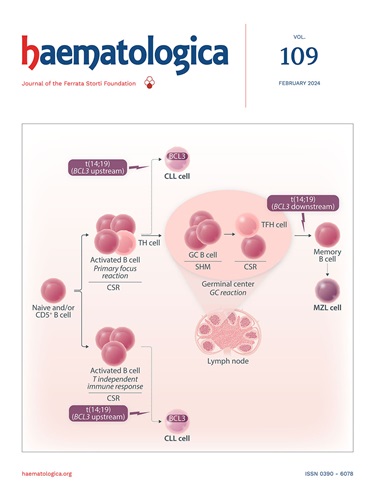Long-term cardiac morbidity in adolescent and young adult survivors of classical Hodgkin lymphoma: the British Columbia experience.
IF 7.9
1区 医学
Q1 HEMATOLOGY
引用次数: 0
Abstract
Adolescents and young adults (AYA) with classic Hodgkin lymphoma (cHL) have excellent survival outcomes, however the late effects of treatment, including cardiovascular disease (CVD), can impact long-term disease-free morbidity and mortality. Using population-level administrative data, we evaluated rates of CVD in 2-year AYA survivors of cHL, aged 16-39 years, treated with ABVD or equivalent chemotherapy, with or without radiotherapy (RT). With a median follow up of 17 years (range 2.3-29 years), risk of CVD was 2.9-fold higher relative to controls, with a 5.2-fold risk of heart failure (HF) and 2.4-fold risk of ischemic heart disease (IHD). Risk of HF was associated with anthracycline-containing chemotherapy regimens alone or with combined modality therapy; whereas higher IHD risk was identified only in those treated with RT. At 20 years after the most recent cHL diagnosis or relapse, the cumulative incidence (CI) of HF was 4.3% in cases vs 0.8% in controls; and for IHD was 8.3% in cases vs 2.8% in controls. Treatment after 2005 using a PET scan guided approach reduced the overall use of RT (56.0% < 2005 vs 14.9% > 2005), and was associated with a lower 15-year CI of IHD (< 2005: 3.4% (95% CI 1.8-5.1%), > 2005: 0.7% (95% CI 0-1.7%) with the latter era comparable to controls; (1.6% (95% CI 1.3-1.9%)). cHL survivors had increased 20-year cumulative mortality above that of age-matched controls (5.0% vs 2.0%). These results can inform surveillance strategies, screening guidelines, and recommendations for risk factor modification for AYA cHL survivors.经典霍奇金淋巴瘤(cHL)的青少年和青壮年(AYA)具有良好的生存结局,然而治疗的后期效应,包括心血管疾病(CVD),可能影响长期无病发病率和死亡率。利用人口水平的管理数据,我们评估了年龄在16-39岁、接受ABVD或同等化疗、伴或不伴放疗(RT)的2年AYA cHL存活患者的CVD发生率。中位随访17年(范围2.3-29年),CVD的风险比对照组高2.9倍,心衰(HF)风险5.2倍,缺血性心脏病(IHD)风险2.4倍。HF的风险与单独使用蒽环类化疗方案或联合使用化疗方案有关;然而,只有接受rt治疗的患者才有较高的IHD风险。在最近一次cHL诊断或复发后20年,HF的累积发病率(CI)在病例中为4.3%,而对照组为0.8%;IHD病例为8.3%,对照组为2.8%。2005年后使用PET扫描引导方法治疗减少了RT的总体使用(56.0% < 2005 vs 14.9% bbb2005),并且与IHD的15年CI较低相关(< 2005:3.4% (95% CI 1.8-5.1%), bbb2005: 0.7% (95% CI 0-1.7%),后者与对照组相当;(1.6% (95% ci 1.3-1.9%))。cHL幸存者的20年累积死亡率高于同龄对照组(5.0% vs 2.0%)。这些结果可以为AYA cHL幸存者的监测策略、筛查指南和危险因素修改建议提供信息。
本文章由计算机程序翻译,如有差异,请以英文原文为准。
求助全文
约1分钟内获得全文
求助全文
来源期刊

Haematologica
医学-血液学
CiteScore
14.10
自引率
2.00%
发文量
349
审稿时长
3-6 weeks
期刊介绍:
Haematologica is a journal that publishes articles within the broad field of hematology. It reports on novel findings in basic, clinical, and translational research.
Scope:
The scope of the journal includes reporting novel research results that:
Have a significant impact on understanding normal hematology or the development of hematological diseases.
Are likely to bring important changes to the diagnosis or treatment of hematological diseases.
 求助内容:
求助内容: 应助结果提醒方式:
应助结果提醒方式:


